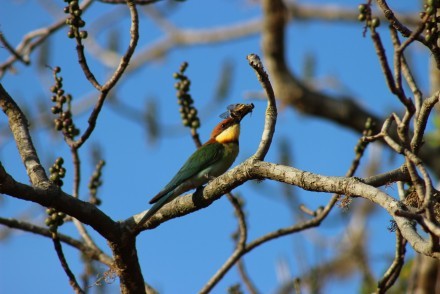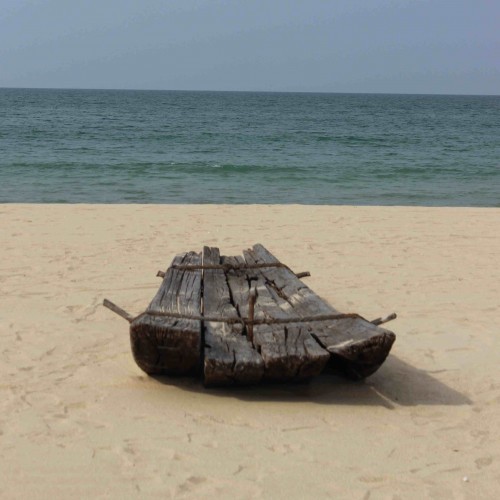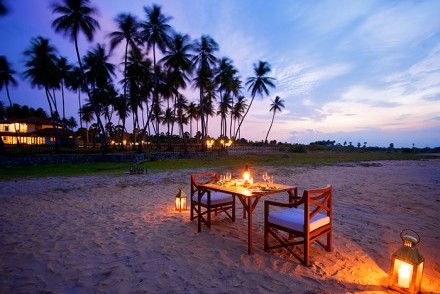Arugam Bay: Site Details
A surfer’s paradise
The principal activities of Arugam Bay are:
- Surfing
- Wildlife
- Cultural Sites

Surfing from Arugam Bay
The Best Breaks on the Island
The famed long right point break at the southern end of Arugam Bay is considered to be the best surf spot in Sri Lanka, offering consistent waves from April to September. Although not one of the great surfing areas of the world, contrary to popular local belief, Arugam Bay consistently produces long and fairly fat (1-1.5 metres) slow-breaking waves that are ideal for intermediate surfers. There are plenty of other breaks in the area of similar quality, although most need a decent swell. To the north, Pottuvil Point (slow right-hander and better later in the season), Whiskey Point and Lighthouse Point are all ideal for beginners. To the south, Crocodile Rock, Elephant Rock, Peanut Farm (one of its two breaks is advanced) and Okanda (potentially the best spot of all) offer waves for more advanced surfies.

Wildlife
Kumana and Lahugala National Parks
Kumana National Park is one of the island’s principal bird sanctuaries, and it is also home to leopards, sloth bears and elephants roaming across the unprotected border from neighbouring Yala West National Park. Spanning 18,150 hectares, Kumana is best known for its abundant bird life, and a considerable number of bird species breed and feed here. One of the most significant features of the park is the Kumana Villu, a 200-hectare natural swamp lake fed by the Kumbukkan Oya, which hosts tens of thousands of migratory birds between April and July. Two hundred and fifty five species of birds have been recorded in Kumana including rare species such as the Black-necked Stork, Lesser Adjutant, Eurasian Spoonbill, Great Thick-knee, Yellow-footed Green Pigeon, Greater Racket-tailed Drongo, Malabar Trogon, Red-faced Malkoha and Sirkeer Malkoha.
Lahugala Kitulana National Park is one of the smallest national parks in Sri Lanka, but despite its diminutive size (1554 hectares), the park is an important habitat for elephants and endemic birds including the Sri Lanka Spurfowl and the rare Red-faced Malkoha. Herds of up to 150 elephants, attracted by the beru grass, are a common sight at Lahugala tank (lake) during July and August.

Cultural Sites
Enigmatic Ruins
Kudimbigala
Inland from Okanda is the enigmatic forest hermitage of Kudimbigala, where hundreds of Buddhist monks once lived in caves, reportedly from the 1st century BC. Hidden away in dense forest between boulders is the Sudasharna Cave, which is a small white shrine half-covered by an overhanging rock outcrop bearing the faint remains of ancient Brahmi script next to an unusual little carving symbolizing the Triple Gem (the Buddha, the Dhamma [the Buddha’s teachings] and the Sangha [the Buddha’s followers] – the central focus of inspiration and devotion for Buddhists). Paths lead through the trees, passing other small shrines and miniature cave temples en route. One path leads to the Madhya Mandalaya, or “Plain of Ruins”, with a small dagoba and other monastic remains scattered over a rocky hilltop. Another path, via rock-cut steps, leads steeply up to the summit of the towering Belumgala rock topped by another small dagoba, which affords magnificent views over the undisturbed and uninhabited jungle to the coast.
Magul Maha Vihara
Close to Lahugala Kitulana National Park are the evocative remains of Magul Maha Vihara, the temple where local King Kavan Tissa and the fabled heroine Queen Vihara Maha Devi were married in the 2nd century BC. The poruwa, the traditional wedding platform erected for the event, has an elaborate lion frieze decoration, which possibly signifies the sovereign status of the couple. Following the ceremony, the area was encircled by a wall and presented to the Sangha (the devout monks adhering strictly to the Buddha’s teachings), who established a monastery on the land. The unexcavated remains of Kavan Tissa’s palace lie south of the temple, where the couple’s son, the legendary Dutugemunu, was born and lived until his teens, when the family moved to Tissamaharama (Tissa). The extensive and enigmatic remains surrounded by thick jungle were rebuilt in the 5th century AD by King Dhatusena of Sigiriya fame and further restored in the mid-14th century and include a Buddha shrine, image house, dagoba, poyage and well-preserved moonstones, as well as the finely-carved poruwa.











